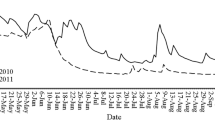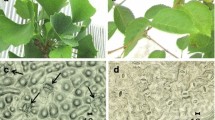Abstract
Compensatory growth responses of Leymus chinensis, a dominant species in Inner Mongolia steppe, to clipping defoliation were evaluated in a pot-cultivated experiment under different nutrient (N and P) and water availability conditions. Leymus chinensis exhibited over-compensatory growth at the light and moderate clipping intensities (20% and 40% aerial mass removed) with a greater accumulated aboveground biomass, higher relative growth rate (RGR), more rhizomatic tillers and a stimulation of compensatory photosynthesis to the remnant leaves as compared with those of the unclipped plants. Intense clipping (80% aerial mass removed), which removed most of the aboveground tissues, greatly reduced the growth of aboveground biomass in comparison with that of the unclipped plants. Nitrogen addition only slightly improved the biomass production and RGR in light and moderately clipped plants, and it did not allow plants in the intense clipping condition to over-compensate. Phosphorus addition had no obvious influences on the growth and physiological responses to clipping defoliation. These results indicated that nutrient addition could not compensate for the negative effects of severe clipping on the defoliated grass. On the other hand, there were no distinct positive responses under water deficiency condition for L. chinensis at all clipping intensities with a significant reduction of aboveground and belowground biomass, lower RGR, fewer rhizomatic tillers, and a lower net photosynthetic rate than other wet treatments. Additionally, the chlorophyll contents of remnant leaves gradually increased with the increase of clipping intensities in each treatment. In conclusion, although L. chinensis could compensate for tissues removal by some morphological and physiological responses, intense clipping and drought can result in a significant decrease of biomass and growth rate, even under enriched nutrition conditions.






Similar content being viewed by others
References
Anten NPR, Ackerly DD (2001) Canopy-level photosynthetic compensation after defoliation in a tropical understorey palm. Funct Ecol 15:252–262
Archer S, Detling JK (1986) Evaluation of potential herbivore mediation of plant water status in a North American mixedgrass prairie. Oikos 47:287–291
Atkinson CJ (1986) The effect of clipping on net photosynthesis and dark respiration rates of plants from an upland grassland, with reference to carbon partitioning in Festuca ovina. Ann Bot 58:61–72
Barthram GT (1997) Shoot characteristics of Trifolium repens grown in association with Lolium perenne or Holcus lanatus in pastures grazed by sheep. Grass For Sci 52:336–339
Belsky AJ (1986) Does herbivory benefit plants? A review of the evidence. Am Nat 127:870–892
Brathen KA, Odasz-Albrigtsen AM (2000) Tolerance of the arctic graminoid Luzula arcuata ssp. confusa to simulated grazing in two nitrogen environments. Can J Bot 78:1108–1113
Busso CA, Mueller RJ, Richards JH (1989) Effects of drought and defoliation on bud viability in two caespitose grasses. Ann Bot 63:477–485
Chapin FS, McNaughton SJ (1989) Lack of compensatory growth under phosphorus deficiency in grazing-adapted grasses from the Serengeti Plains. Oecologia 79:551–557
Chapin FS, Schulze ED, Mooney HA (1990) The ecology and economics of storage in plants. Annu Rev Ecol Syst 21:423–427
Cheng CM, Cao CY (1996) Transformation and availability of inorganic phosphorus in different soil during the paddy-upland rotation of soils. J Nanjing Agr Univ 19:32–36
Coughenour MB, Detling JK, Bamberg IE et al (1990) Production and nitrogen responses of the African dwarf shrub Indigofera spinosa to defoliation and water limitation. Oecologia 83:546–552
Del-Val EK, Crawley MJ (2005) Are grazing increaser species better tolerators than decreasers? An experimental assessment of defoliation tolerance in eight British grassland species. J Ecol 93:1005–1016
Edenius L, Danell K, Bergstrom R (1993) Impact of herbivory and competition on compensatory growth in woody plants: winter browsing by moose on Scots pine. Oikos 66:286–292
Evans AS (1991) Whole-plant responses of Brcassica campestris to altered sink-source relations. Am J Bot 78:394–400
Ferraro DO, Oesterheld M (2002) Effect of defoliation on grass growth. A quantitative review. Oikos 98:125–133
Georgiadis NJ, Ruess RW, McNaughton AJ et al (1989) Ecological conditions that determine when grazing stimulate grass production. Oecologia 81:316–322
Hamilton EW III, Giovannini MS, Moses SA et al (1998) Biomass and mineral element responses of a Serengeti short-grass species to nitrogen supply and defoliation: compensation requires a critical [N]. Oecologia 116:407–418
Hilbert DW, Swift DM, Dehing JK et al (1981) Relative growth rates and the grazing optimization hypothesis. Oecologia 51:14–48
Holland JN, Cheng WX, Crossley DA (1996) Herbivore-induced changes in plant carbon allocation: assessment of belowground C fluxes using carbon-14. Oecologia 107:87–94
Hoogesteger J, Karlsson PS (1992) Effects of defoliation on radial stem growth and photosynthesis in the Mountain Birch (Betula pubescens ssp. tortuosa). Funct Ecol 6:317–323
Jacobs JS, Sheley RL (1999) Grass defoliation intensity, frequency and season effects on spotted knapweed invasion. J Range Manage 52:626–632
Katoh K, Takeuchi K, Jiang D et al (1998) Vegetation restoration by seasonal exclosure in the Kerqin Sandy Land, Inner Mongolia. Plant Ecol 139:133–144
Lacery JR, Van Poollean HW (1981) Comparison of herbage production on moderately grazed and ungrazed western ranges. Rangeland Manage 34:210–212
Lehtilä K (2000) Modelling compensatory regrowth with bud dormancy and gradual activation of buds. Evol Ecol 14:315–330
Liu YR, Yang C, Zhu ZM et al (2004) Soil C and N dynamics during desertification of grassland in Northern China. Chin J Appl Ecol 15:1604–1606
Liu HD, Yu FH, He WM et al (2007) Are clonal plants more tolerant to grazing than co-occurring non-clonal plants in inland dunes? Ecol Res 22:502–506
Mabry CM, Wayne PW (1997) Defoliation of the annual herb Abutilon theophrasti: mechanisms underlying reproductive compensation. Oecologia 111:225–232
Martens B, Trumble J (1987) Structural and photosynthetic compensation for leafminer (Diptera: Agromyzidae) injury in limabeans. Environ Entomol 16:387–380
Maschinski J, Whitham TG (1989) The continuum of plant responses to herbivory: the influence of plant association, nutrient availability and timing. Am Nat 134:l–l9
McNaughton SJ (1986) On plant and herbivores. Am Nat l28:765–770
McNaughton SJ, Chapin FS (1985) Effects of phosphorous nutrition and defoliation on C4 graminoids from the Serengeti plains. Ecology 66:1617–1629
McNaughton SJ, Wallace LL, Coughenour MB (1983) Plant adaptation in an ecosystem context: effects of defoliation, nitrogen, and water on growth of an African C4 sedge. Ecology 64:307–318
Meyer GA (1998) Mechanisms promoting recovery from defoliation in goldenrod (Solidago altissima). Can J Bot 76:450–459
Nowak RS, Coldwell MM (1984) A test of compensatory photosynthesis in the field: implications for herbivory tolerance. Oecologia 6l:311–318
Noy-Meir I (1993) Compensating growth of grazed plants and its relevance to the use of rangelands. Ecol Appl 3:32–34
Oesterheld M (1992) Effect of defoliation intensity on aboveground and belowground relative growth rates. Oecologia 92:313–316
Oesterheld M, Loreti J, Semmartin M et al (1999) Grazing, fire, and climate as disturbances of grasslands and savannas. In: Walker L (ed) Ecosystems of disturbed ground. Elsevier, Oxford, pp 303–322
Oesterheld M, McNaughton SJ (1988) Intraspecific variation in the response of Themeda triandra to defoliation: the effect of time of recovery and growth rates on compensatory growth. Oecologia 77:181–186
Oesterheld M, McNaughton SJ (1991) Effect of stress and time for recovery on the amount of compensatory growth after grazing. Oecologia 85:305–313
Painter E, Belsky AJ (1993) Application of herbivore optimization theory to rangelands of the western United States. Ecol Appl 3:2–9
Parsons AJ, Leafe EL, Collett B et al (1983) The physiology of grass production under grazing I. Characteristics of leaf and canopy photosynthesis of continuously-grazed swards. J Appl Ecol 20:117–126
Parsons AJ, Penning PD (1988) The effects of the duration of regrowth on photosynthesis, leaf death and average rate of growth in a rotationally grazed sward. Grass For Sci 44:16–38
Reichman OJ, Smith SC (1991) Responses to simulated leaf and root herbivory by a biennial, Tragopogon dubius. Ecology 72:116–124
Richards JH (1993) Physiology of plants from defoliation. In: Baker MJ (ed) Grassland for our word. Sir Publishing, New Zealand, pp 47–55
Richards JH, Caldwel1 MM (1985) Soluble carbohydrate, concurrent photosynthesis and efficiency in regrowth following defoliation: a field study with Agropyton species. J Appl Ecol 22:907–920
Rodríguez D, Andrade FH, Goudriaan J (2004) Effects of phosphorus nutrition on tiller emergence in wheat. Plant Soil 209:283–295
Rosenthal JP, Kotanen PM (1994) Terrestrial plant tolerance to herbivory. Trends Ecol Evol 9:145–148
Senock RS, Sisson WB, Donart GB (1991) Compensatory photosynthesis of Sporobolus flexuosus (Thurb.) Rybd. following simulated herbivory in the northern Chihauhan desert. Bot Gaze 152:275–281
Sosebee RE, Wester DB, Villalobos JC et al (2005) How grasses grow-how plant growth relates to grazing management. Acta Pratacul Sin 14:117–125
Trlica MJ, Rittenhouse LR (1993) Grazing and plant performance. Ecol Appl 3:21–23
Van Staalduinen MA, Anten NPR (2005) Differences in the compensatory growth of two co-occurring grass species in relation to water availability. Oecologia 146:190–199
Walker MD, Webber PJ, Arnold EH (1994) Effects of inter annual climate variation on aboveground phytomass in Alpine vegetation. Ecology 75:393–408
Wallace LL (1990) Comparative photosynthetic responses of big bluestem to clipping versus grazing. J Range Manage 44:59–62
Wan CG, Sosebee RE (2002) Tiller recruitment and mortality in the dryland bunchgrass Eragrostis curvula as affected by defoliation intensity. J Arid Environ 51:577–585
Wang SP, Wang YF (2001) Study on over-compensation growth of Cleistogens squarrosa population in Inner Mongolia steppe. Acta Bot Sin 43:413–418
Wang YH, Zhou GS (2004) Responses of temporal dynamics of aboveground net primary productivity of Leymus chinensis community to precipitation fluctuation in Inner Mongolia. Acta Ecol Sin 24:1140–1145
Wang ZW, Li LH, Han XG et al (2004) Do rhizome severing and shoot defoliation affect clonal growth of Leymus chinensis at ramet population level? Acta Oecol 26:255–260
Woodrnansee RO, Puncan PA (1980) Nitrogen and phosphorus dynamics and budgets in annual grassland. Ecology 61:893–904
Xia JX, Hodgson C, Matthew C et al (1990) Tiller population and tissue turnover in a perennial ryegrass pasture under hard and lat spring and summer grazing. Proc New Zealand Grassland Assoc 51:119–122
Yordanov I, Velikova V, Tsonev T (2000) Plant responses to drought, acclimation, and stress tolerance. Photosynthetica 38:171–186
Yuan ZY, Li LH, Han XG et al (2005) Soil characteristics and nitrogen resorption in Stipa krylovii native to northern China. Plant Soil 273:257–268
Zhang X, Wu N, Li C (2005) Physiological and growth responses of Populus davidiana ecotypes to different soil water contents. J Arid Environ 60:567–579
Acknowledgements
This research was supported in part by a Knowledge Innovation Project of the Chinese Academy of Sciences (KSCX2-SW-127) to GH Lin, grants from National Natural Science Foundation of China (30521002 and 90511001) and a “Hundred Talents Program” Project of the Chinese Academy of Sciences to GH Lin. We greatly appreciate Dr. Qing-Zhong Zhang and Dr. Zhi-Yong Zhou for their assistances during the experiment and greatly thank Dr. Wei Sun for his assistance in the revision of this paper. The authors also would like to express their deep gratitude to the two anonymous reviewers, whose comments are valuable in the improvement of this paper.
Author information
Authors and Affiliations
Corresponding author
Rights and permissions
About this article
Cite this article
Zhao, W., Chen, SP. & Lin, GH. Compensatory growth responses to clipping defoliation in Leymus chinensis (Poaceae) under nutrient addition and water deficiency conditions. Plant Ecol 196, 85–99 (2008). https://doi.org/10.1007/s11258-007-9336-3
Received:
Accepted:
Published:
Issue Date:
DOI: https://doi.org/10.1007/s11258-007-9336-3




